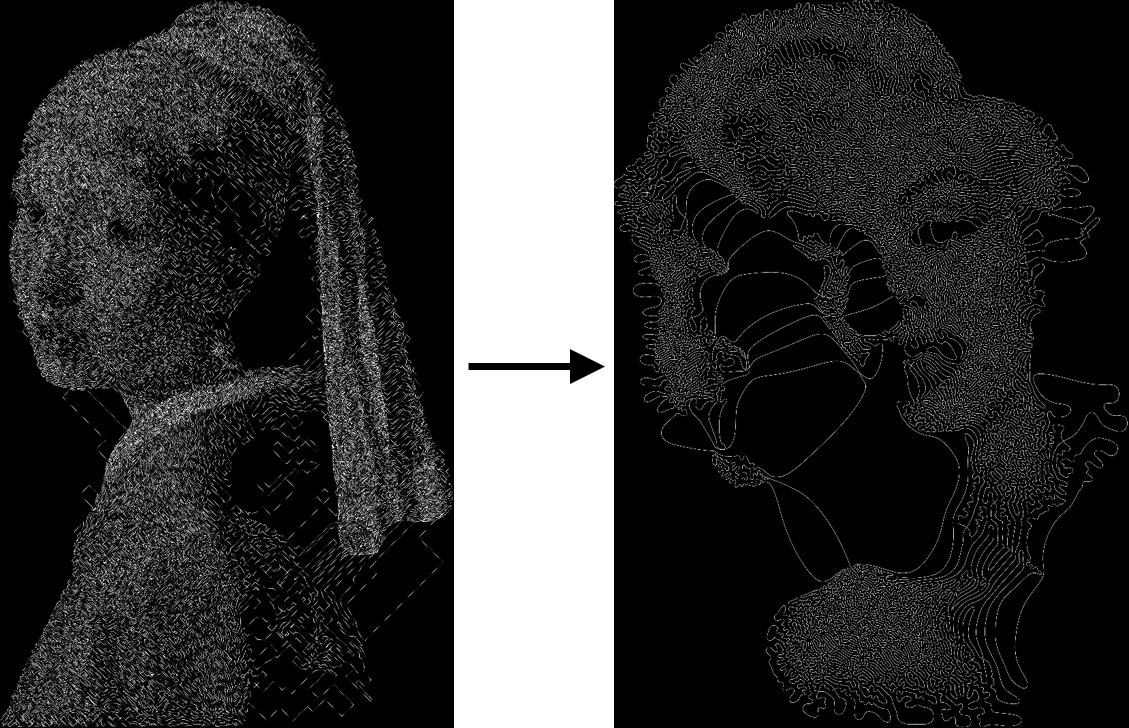The arrival of high-field MRI at 7 teslas (7 T) and soon 11.7 T, makes it possible to observe the human body with ever-increasing resolutions. These high-precision images naturally come with an increase in data acquisition time: with current technologies, collecting data on a human brain from the side using a 7 T MRI with 100 μm resolution would take up to 12 hours! In other words, it would take forever. Researchers at CEA-I2BM are seeking to reduce this acquisition time, with a first objective of limiting it to 20 minutes for a 200 μm resolution.
How? The solution lies in the creativity of mathematicians who imagine algorithms with new sampling techniques. Philippe Ciuciu from CEA-I2BM takes us on a journey in this arduous yet fascinating world of gradients and integrals. It is a parallel world, called the Fourier space, in which the researchers project the energy distribution of the signal collected by MRI as a function of the frequency.
"We work in this space, a compact representation of reality," Ciuciu says. "The most basic way of sampling is through a grid of regularly spaced points. Ten years ago, a Frenchman and an American invented compressed sensing, a signal processing technique to pseudo-randomly acquire non-redundant information by deviating from the grid." This collection of measurements is carried out from point to point. The difficulty lies in constructing a continuous trajectory connecting these points. Researchers at CEA-I2BM and their colleagues from CNRS were the first to propose to solve the problem of the commercial traveler (who looks for the shortest route between all the cities) to determine the trajectory linking the different sampling points. Yet this trajectory in the Fourier space is not satisfactory due to its angular points:
"This trajectory must be physically plausible, meaning that it must respect the constraints of the gradient system," Ciuciu says. The whole process can be seen as a car that sometimes has to take tight turns. "There is no way the car can speed like a F1 car, because it would be out of the way in no time" he said. "The Americans chose to limit the speed by staying on the trajectory of the circuit. What we did was to develop a method for rounding the trajectory when approaching an angular point in order to gain travel time and therefore to accelerate MRI image acquisition."
Another advance proposed by the researchers from CEA-I2BM lies in the simultaneous optimization of the random drawing of the points and the design of the trajectory. It turns out that the measurements of the signal at low frequencies, at the center of the Fourier space, carry more information than the high frequencies. Intuitively, a spiral starting at the center would be a good alternative for an optimal sampling of the points of interest. "It is the case, but we have found even better," Ciuciu said, excited. "The curves we propose have a very effective regularity and canvas." The overall design of the canvas can be diverse as long as it covers the entire Fourier space quickly enough, according to the right density, and meets the constraints on the gradients.
 Example of sampling a photo of Marylin Monroe starting from an initialization of curves projected on the painting of the girl with the pearl, by J. Vermeer(c) CEA
Example of sampling a photo of Marylin Monroe starting from an initialization of curves projected on the painting of the girl with the pearl, by J. Vermeer(c) CEA
The scientists have shown that this method is generic and can be applied to process any image from any initialization: why not the portrait of Marilyn Monroe from Johannes Vermeer's painting of the "Girl with a Pearl Earring" (see here)? "Applied to MRI, this method will divide the acquisition times at 7 T by sixteen!" he said. The acquisition times of future 11.7 T MRI will therefore become reasonable for high-resolution images. "Our algorithm is easy to adapt," Ciuciu concluded. "It may also significantly accelerate the acquisition times of 3 T MRIs, thus increasing the availability of the MRIs currently used in clinics."
_____
*About the fields used in MRI :
MRI uses a static magnetic field (3 T, 7 T, etc.), which aligns all the spins of atomic nuclei in the same direction. Lower oscillating RF fields (~ 100 MHz) slightly alter this alignment and create a resonance signal. In addition, small magnetic field gradients make it possible to locate the signal in space. They are created by a distribution of small coils between 40 and 80 mT, which vary the resonant frequencies of the spins to associate a position on the image to a frequency in the Fourier space.
From the "jeune fille" to Marylin Monroe in movie